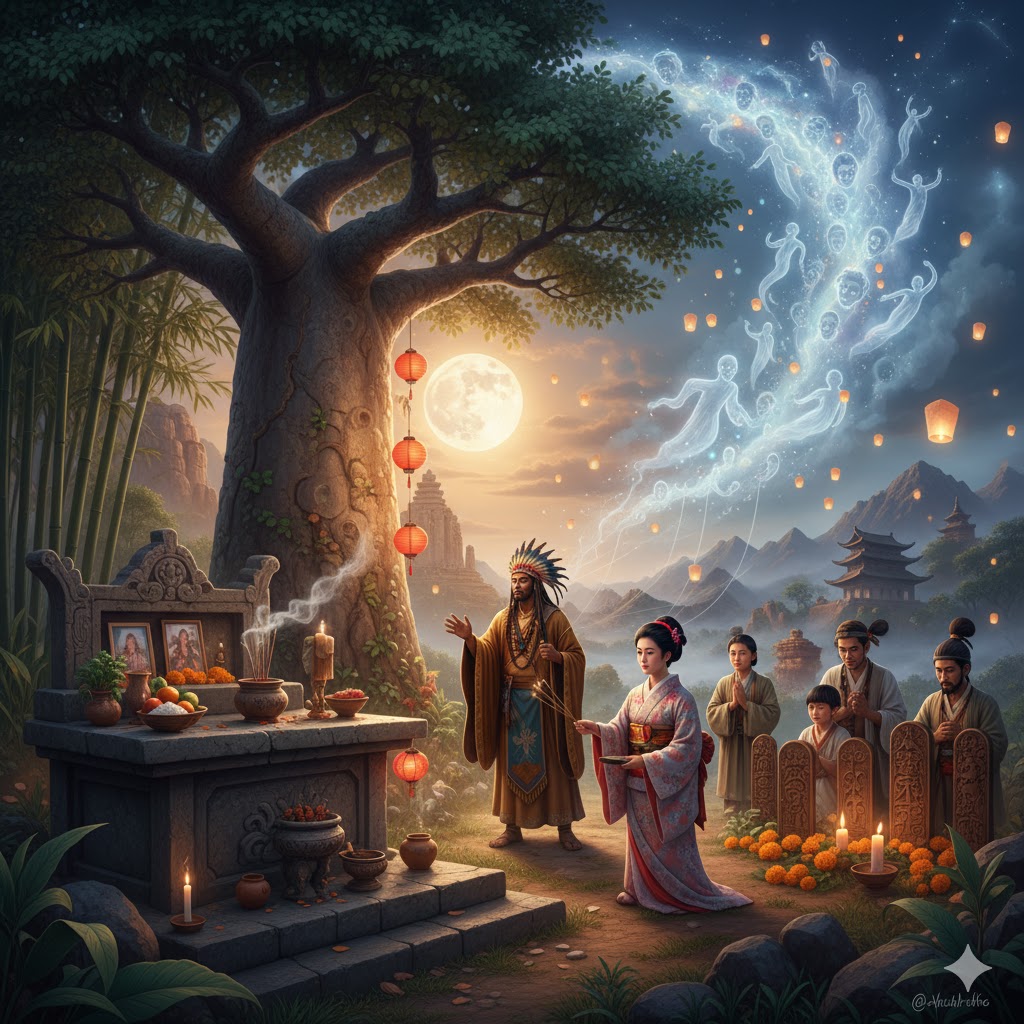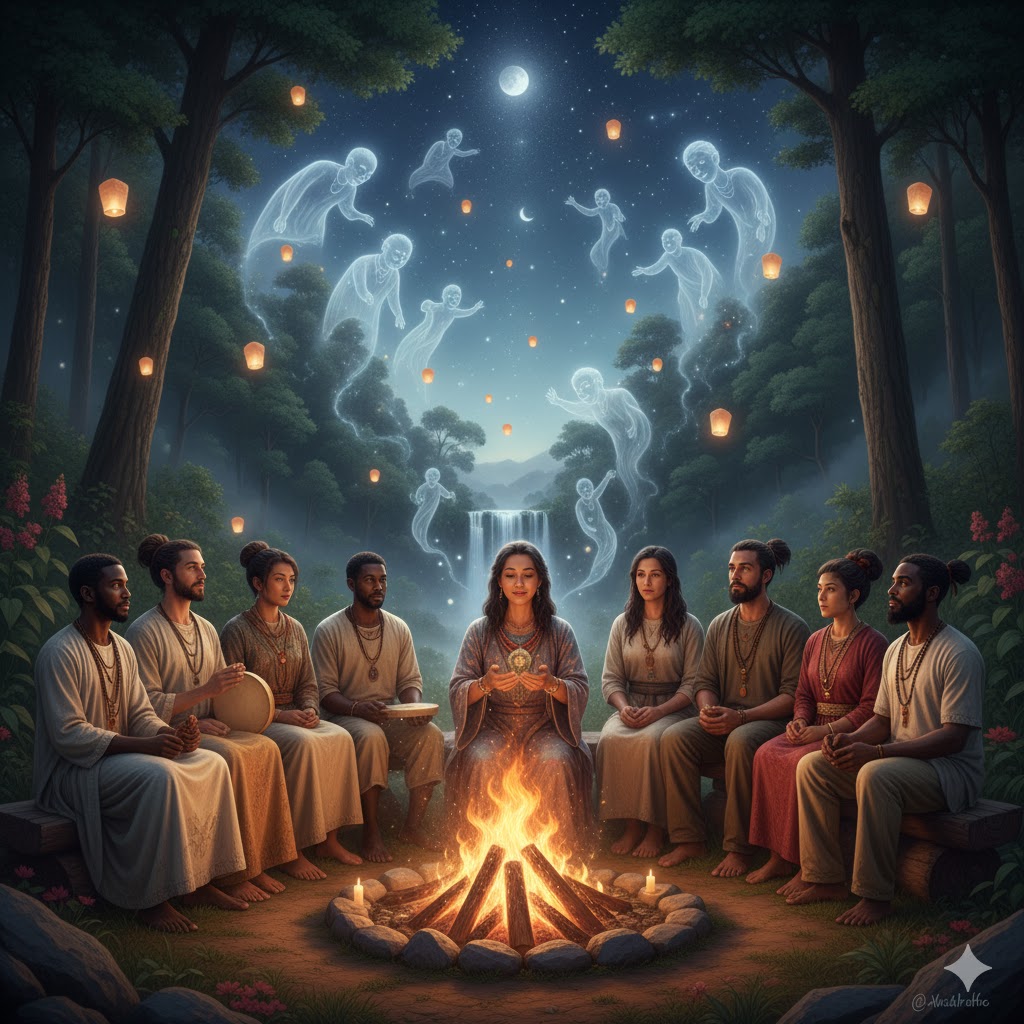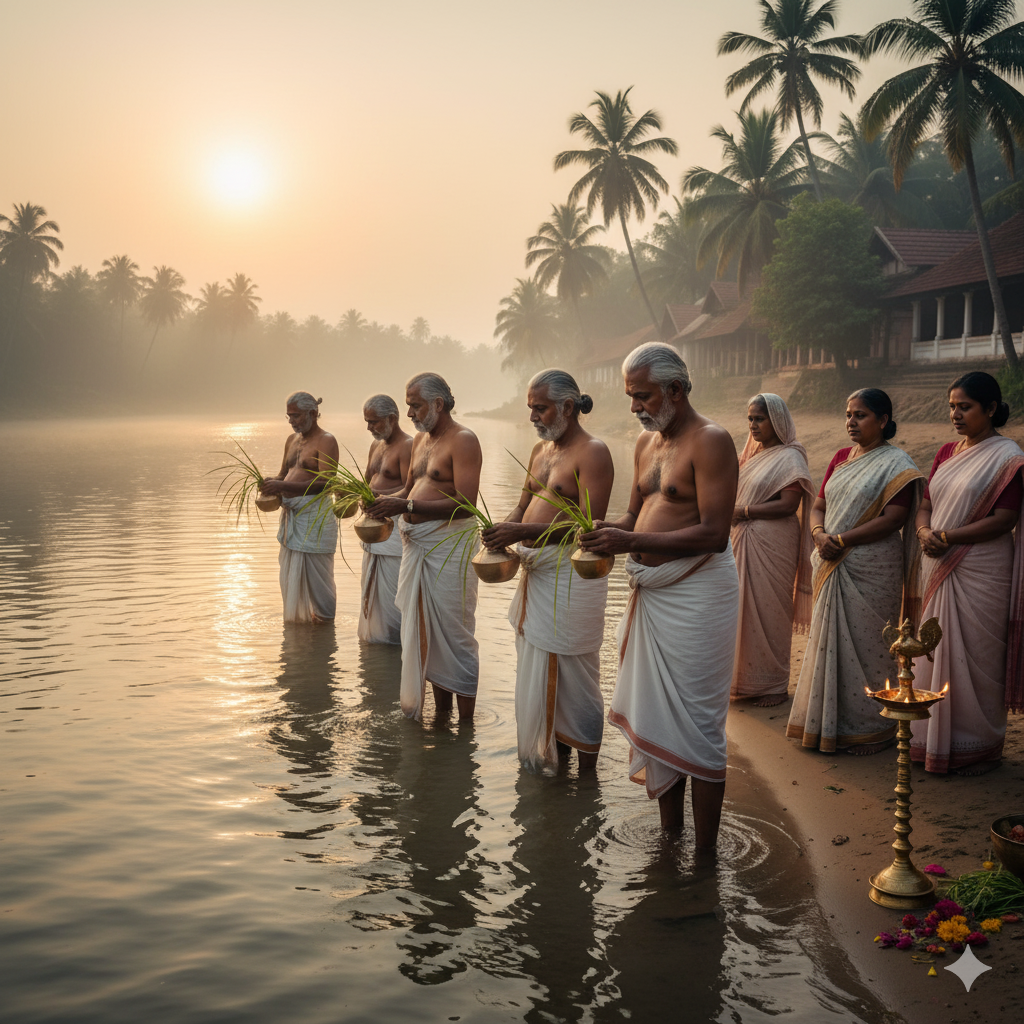The Ancestral Veil and the Spirit Wild: A Global Comparison of Veneration and Worship

AI generated image
I. Introduction: Mapping the Invisible World
The study of folklore and comparative religion reveals that humanity’s spiritual landscape is structured by fundamental relationships, none more persistent than the dialogue between the living and the dead. The spiritual world, as conceived across millennia and cultures, is often compartmentalized into two broad, yet interrelated, categories: the Spirits of Kinship (Ancestors), who enforce human social structure, and the Spirits of Nature and Place (Generalized Spirits), who represent the immanent and often unpredictable forces of the cosmos. This report dissects the conceptual, ritual, and sociological boundaries of these two traditions worldwide, demonstrating that while both systems are profoundly ancient, they serve distinct, though sometimes overlapping, societal functions.
The practice of communicating with or venerating the departed dates back to pre-literate cultures, rooted in animism or early ancestor worship.1 However, the distinction between a revered forebear and a powerful, non-kin spiritual entity is crucial for anthropological analysis. Ancestor worship is fundamentally an institution of social control, lineage continuity, and moral enforcement.2 Conversely, generalized spirit belief, which includes animism and shamanism, primarily addresses immediate existential concerns such as healing, environmental relations, and divination, focusing on forces external to the immediate family structure.3
The complex interplay between these spiritual categories is vividly illustrated in specific regional traditions. In South Asia, particularly in the Tulu Nadu and northern Kerala regions, traditions such as the Bhoota Kola merge localized deity worship (Daivas)—a form of generalized, localized spirit veneration—with profound social arbitration and community structuring.4 This system, where localized protector spirits are invoked for justice and governance, highlights the necessity for a precise, comparative study to understand how different societies mobilize spiritual power for stability and meaning.
II. Conceptual Foundations and Academic Debates
Distinguishing the Sacred Categories: Ancestor Cults vs. Generalized Spirits
The vocabulary used by scholars to describe interactions with the spiritual realm is subject to rigorous debate, reflecting substantive differences in the nature and function of the entities involved. Clarifying the definitions of ancestor cults and generalized spirit veneration is the first step toward a global comparative analysis.
Ancestor Worship: The Cult of Kinship and Lineage
Ancestor worship, or ancestor veneration, refers specifically to rituals designed to commemorate and venerate the spirits of one's deceased forebears—the specific relatives who preceded the living generation.5 These practices are not mere acts of remembrance; they are formalized rites intended to cultivate kinship values, uphold filial piety, and ensure the continuity of the family lineage.6
The longevity and profound influence of this practice are evident in East Asia. Chinese ancestor practices, dating back to the Neolithic period, were formalized through offerings to ancestral tablets or images, collective veneration at ancestral halls, and gravesite rituals such as the Qingming (Gravesweeping) Festival.9 The motivation is two-fold: an expression of respect and duty (filial piety) and a practical effort to pacify the spirits, ensuring positive cosmic flow (qi) for the descendants.13
A critical conceptual distinction in anthropology was drawn by Gluckman, who differentiated strict ancestor worship from the cult of the dead.2 Ancestors, in the strict sense, are exclusively deceased kinsmen and represent positive moral forces who require their descendants to observe a moral code. They possess the power to cause or prevent misfortune contingent upon the observance of this code. In contrast, the cult of the dead is directed toward spirits of the dead in general (non-kin) and may be sought for the achievement of amoral or even antisocial goals. This bifurcation underscores a core characteristic: ancestor worship is inherently conservative, protecting the existing social order, while generalized spirits exist outside that primary framework, potentially representing disruptive or external forces.
This differentiation also helps explain the chronological evolution of religious traits in human societies. Phylogenetic reconstructions suggest that Animism, the belief in spiritual essence in all things, is the oldest trait of religion, present in the most recent common ancestor of present-day hunter-gatherers.6 Belief in an afterlife and shamanism emerged next, followed by ancestor worship. This sequence implies that ancestor worship requires a more structurally complex society, one based on fixed lineage structures and property inheritance (typical of settled societies), enabling the institutionalization of jural authority across generations. The establishment of formalized ancestor cults transforms the biological fact of death into an immutable social fact, stabilizing the lineage structure.
Generalized Spirits: Animism, Place, and the Amoral Dead

AI generated image
The concept of generalized spirits is rooted in Animism, a worldview that perceives all material phenomena—animals, plants, rivers, rocks, and even abstract concepts like words—as possessing a distinct spiritual essence, agency, and free will.5 In this perspective, the spiritual and physical worlds are not categorically distinct but are interwoven.
A significant subset of generalized spirits are the Spirits of Place, known conceptually as Genius Loci. These are local guardian spirits tied directly to geographical features or constructed environments.14 This belief profoundly impacts human interaction with the environment, generating a sense of sacredness associated with certain places. The relationship established with these entities is based on respectful reciprocity; unlike the unconditional duty owed to kin ancestors, nature spirits operate on an exchange system, responding accordingly if one is deemed a friend or foe.16
Generalized spirits also include entities channeled via Shamanism. Shamanism involves a practitioner interacting with the spirit world through altered states of consciousness, typically for purposes of healing, divination, or direction.4 This practice, found globally from Mongolia (Tengerism) to indigenous Hindu communities in India (where a person is possessed by a deity like a Kuldevta), invokes spirits external to the practitioner’s immediate lineage.17 The relationship is often immediate and transactional, contrasting with the formalized, calendrical rites required for long-term lineage maintenance.
Terminological Nuance: The 'Worship' vs. 'Veneration' Debate
The terminological choice between "worship" and "veneration" is not merely semantic; it carries significant scholarly and theological weight.18 Many academics and religious bodies prefer the term "veneration" to describe ancestor rites. Veneration implies deep respect, honor, and communion, whereas "worship" (latria) often implies adoration reserved for a Supreme Being (particularly within monotheistic faiths like Christianity or Islam).
For instance, Vietnamese Catholic authorities have navigated historical persecution by describing their deep-rooted ancestor-focused traditions as veneration rather than worship, allowing the practice to persist alongside Christian doctrine.19 From a functionalist perspective, however, the critical feature remains the performance of specific rites carried out with reference to deceased members of the lineage. Regardless of whether they are labelled "gods" or "guides," these practices perform the indispensable social role of group cohesion and intergenerational relationship management.12


III. The Social Function of Lineage Veneration (Ancestor Worship)
The universal practice of ancestor worship is a complex mechanism for institutionalizing authority, ensuring social continuity, and defining moral codes. Across various continents, the spirits of the dead are mobilized to reinforce the existing order of the living.
East Asian Structures: Filial Piety and the Confucian Order
In East Asia, the social function of ancestor veneration is deeply embedded in the Confucian framework of xiao (filial piety).9 This practice is viewed as an aspect of Chinese traditional religion that complements the ideology of Confucianism, focusing largely on male ancestors and requiring ritual celebration organized within lineage societies.13
The rituals themselves are highly structured and prescriptive. In Korea, ancestor worship, known generically as jerye or jesa, was formalized under Neo-Confucianism, defining memorial rites across four generations of ancestors.12 These rites, such as Sasije (seasonal rites) and Giyilje (rites on the death anniversary), are performed with the utmost sincerity, teaching descendants filial affection and ensuring the social and moral fabric of the family.21 The rituals also served a political purpose; the veneration of imperial ancestors was incorporated into China's official state religion,9 and Korean rites like Jongmyo jerye were dedicated to ancient kings, legitimizing state authority through ancestral sanction.12
The widespread adoption of these complex rites demonstrates a highly effective ideological technology: the act of death is ritually transformed into an enduring social principle. Rites like the Jongmyo Jerye utilize symbolic performances, such as 64 dancers representing the complementary forces of Yin and Yang, to concretize the moral boundaries and guidelines of the social group for the living participants.22
African Descent Systems: Ancestors and the Jural Domain
In many African cultures, ancestor cults provide the foundation for socio-political organization, acting as intermediaries between the living community and the spiritual world.12 Classic studies of West African ancestor cults, such as those conducted by Meyer Fortes and Jack Goody on the Tallensi and Lodagaa of northern Ghana, highlight the ancestor’s function within the politico-jural domain.25
Fortes famously argued that ancestor worship is a direct “representation or extension of the authority component in the jural relations of successive generations.”27 This authority is not based on the ancestor’s personality or achievements during life, but rather stems from their genealogically structured position with respect to the living.27 The ancestor is an idealized figure, representing “the abstracted principles of lineage structure, authority and values.”28 This process ensures that any man who dies leaving a son becomes an ancestor with an equal measure of formal authority, regardless of his status in life, thus stabilizing the descent system.27
The consequence of neglecting this jural authority is misfortune, meaning ancestors actively ensure that descendants observe the community’s moral code.2 Consequently, the central goal of ancestor veneration in these societies is to ensure the ancestor's continued positive disposition towards the living community, often involving sacrifices and prayers.12
Polynesian Mana and Ancestral Guidance
The Polynesian spiritual system offers a model where the ancestral power is conceptualized as a flow of inherited vitality. Pre-Christian Polynesians perceived their ancestors ('aumakua) as the living edge of a spiritual continuum that linked the present generation back to the major spirits (akua) and the ultimate creators.29 This structure is powered by Mana, the potent life force and charisma that flows down the hereditary channel of seniority.29
The ancestral spirits in this context often serve as specialized guides. Canoe makers, for instance, would pray specifically to deceased ancestors renowned for their skill in canoe construction; similarly, physicians sought guidance from famous ancestral healers.29 This highlights ancestor worship not just as a mechanism for authority, but as a practical means for the transfer of inherited skill and specialized power, reinforcing authority based on seniority and lineage skill.29
Table 1: Comparative Social Function of Ancestor Worship
IV. The Geography of Generalized Spirit Veneration
Spirits of Place, Nature, and the Shamanic World
While ancestor worship focuses inward on the organization of the kinship group, generalized spirit veneration looks outward, establishing a dialogue with the broader, non-human, spiritual environment.
Animistic Consciousness: Entities of the Natural World
Animism defines a worldview where there is no fundamental division between the spiritual and physical reality.5 Entities that are otherwise categorized as inanimate—rivers, mountains, rocks, and plants—are considered to be animated, possessing sentience, agency, and personhood.5 This belief system, identified as the fundamental and oldest trait of religion, creates a spiritual ecology where human beings must negotiate their existence within a “larger-than-human community.”31
The resulting ethical framework is one of respect and reciprocity. Indigenous animistic and shamanistic beliefs, such as those blended with Mahayana Buddhism in Bhutan, influence community-based natural resource management, shaping the relationship with forests and waterways.32 The concept of Genius Loci captures this essence, providing a framework for understanding the sacredness tied to specific locales, such as the religious culture of Bhaktapur, Nepal.14 The pervasive belief that the world is alive and permeable (sometimes described as the “porous mind”) stands in contrast to systems that impose a highly transcendent spiritual reality.33
It is important to note that while this worldview conceptually views nature as sentient (“people like us”),30 the presence of generalized spirit belief does not automatically ensure environmental sustainability. Historical and economic pressures can supersede spiritual reverence, meaning the framework for ecological responsibility provided by animism must be translated into specific cultural practices to have protective ecological effect.34
Shamanism: Intercession and the World of Trance
Shamanism provides the mechanism for interaction with these external, generalized spirits. It relies on a practitioner (shaman) entering altered states of consciousness, such as trance, to direct spiritual energies into the physical world.4 These activities often involve interaction with non-kin spirits for purposes outside of lineage maintenance, such as healing, solving community disputes, or divination.4
Global examples of shamanic traditions include Mongolian Shamanism (Tengerism) and the Ainu peoples of Japan, who practice an animistic faith centering around sacred animals like bears.17 Within Hindu traditions, practices like Bhoota Kola in coastal Karnataka involve possession by the spirit of a deity or protector god (Kuldevta), enabling the spirit to communicate and intervene.4 Shamanic practices, therefore, focus on immediate intervention and transient interactions with the cosmos, setting them apart from the highly regulated, scheduled obligations of ancestor worship.
Case Study: Kami and the Shinto Synthesis
The traditional Shinto religion of Japan offers a compelling illustration of the synthesis between nature spirits and ancestor veneration, often blurring the lines between them. Kami are defined as deities, divinities, spirits, or natural phenomena that are venerated.35 Kami can be elements of the landscape (nature forces) or the spirits of venerated dead people.35
In Shinto, some great leaders or highly virtuous ancestors became Kami upon their death.35 However, scholars studying this tradition stress the functional separation that emerged historically: while Shinto's rituals concern themselves with Kami and the souls of Kami, Buddhism largely took on the role of managing the souls of ordinary people who had lived and died.36 This distinction facilitated a division of labor where Shinto focused on the deified, powerful spirits (both nature-based and exceptional ancestors), while Buddhism managed the private, familial duties toward common ancestors.36 This structural arrangement demonstrates a deliberate effort to separate the worship of highly powerful, potentially transcendent spirits from the maintenance of specific, kinship-based ties.